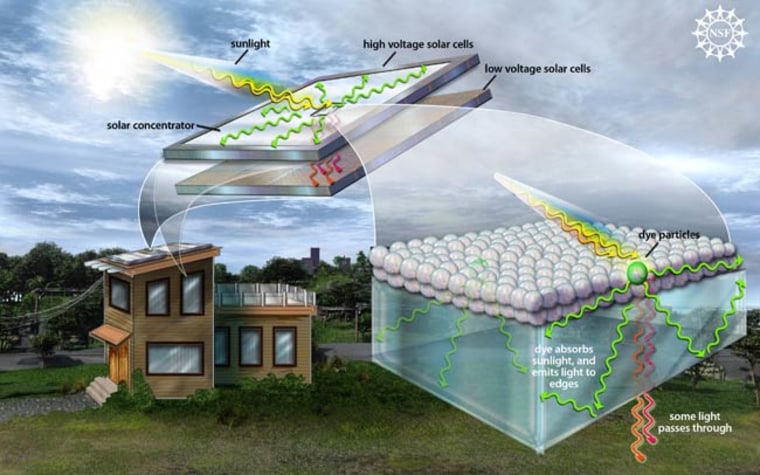A new, compact way to collect sunlight from windows and focus it to generate more electricity could make those multiple expensive rooftop solar panels a thing of the past.
The solar panels that cover the tops of some buildings today contain photovoltaic cells that convert sunlight into electricity. Unlike burning coal, collecting and converting solar energy releases no greenhouse gases, which warm the atmosphere. Limited efficiency and high construction costs have kept solar from producing more than about 0.07 percent of U.S. energy needs in 2007, according to figures from the U.S. Department of Energy.
"Solar concentrators" can be used to increase the electrical power obtained from the photovoltaic cells. But most concentrators in use today "track the sun to generate high optical intensities, often by using large mobile mirrors that are expensive to deploy and maintain," said MIT's Marc A. Baldo, who led the team that created the new type of solar concentrator.
New approach
Instead of covering a large area with solar cells, the new method only requires locating cells around the edges of a flat glass panel.
The MIT solar concentrator involves a mixture of two or more dyes painted onto a pane of glass or plastic. The dyes absorb light across a range of wavelengths, reemit it at a different wavelength and transport it across the pane to the solar cells at the edges.
"Light is collected over a large area [like a window] and gathered, or concentrated, at the edges," Baldo said.
Focusing the light like this increases the electrical power generated by each solar cell "by a factor of 40," he added.
The work was funded by the National Science Foundation and the U.S. Department of Energy's Office of Science.
Old idea
Scientists had tried using similar solar concentrators in the 1970s, but abandoned the idea when not enough of the collected light reached the edges of the concentrator. The MIT engineers revamped the idea by using a mixture of dyes in specific ratios, which allows some level of control over how the light is transmitted.
"We made it so the light can travel a much longer distance," said study team member Jon Mapel, an MIT graduate student. "We were able to substantially reduce light transport losses, resulting in a tenfold increase in the amount of power converted by the solar cells."
Because the system, detailed in the July 11 issue of the journal Science, is simple to manufacture, the team thinks that it can be implemented within three years. It could also be added on to existing solar-panel systems, increasing their efficiency and reducing the cost of solar energy.
